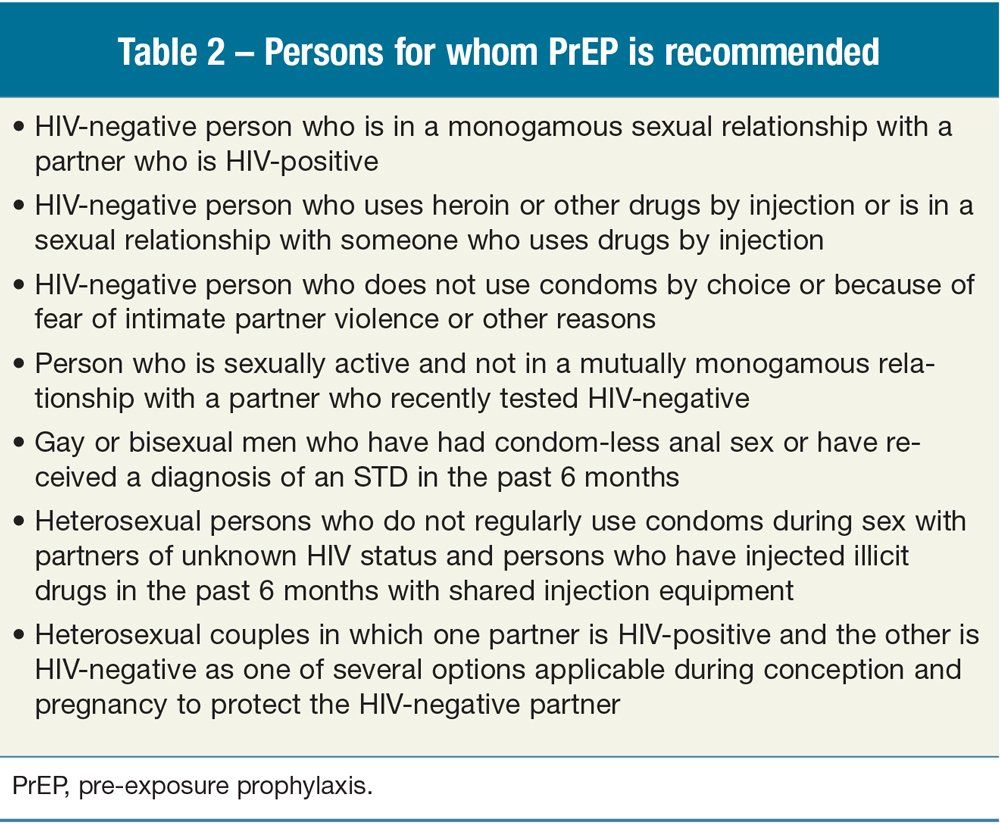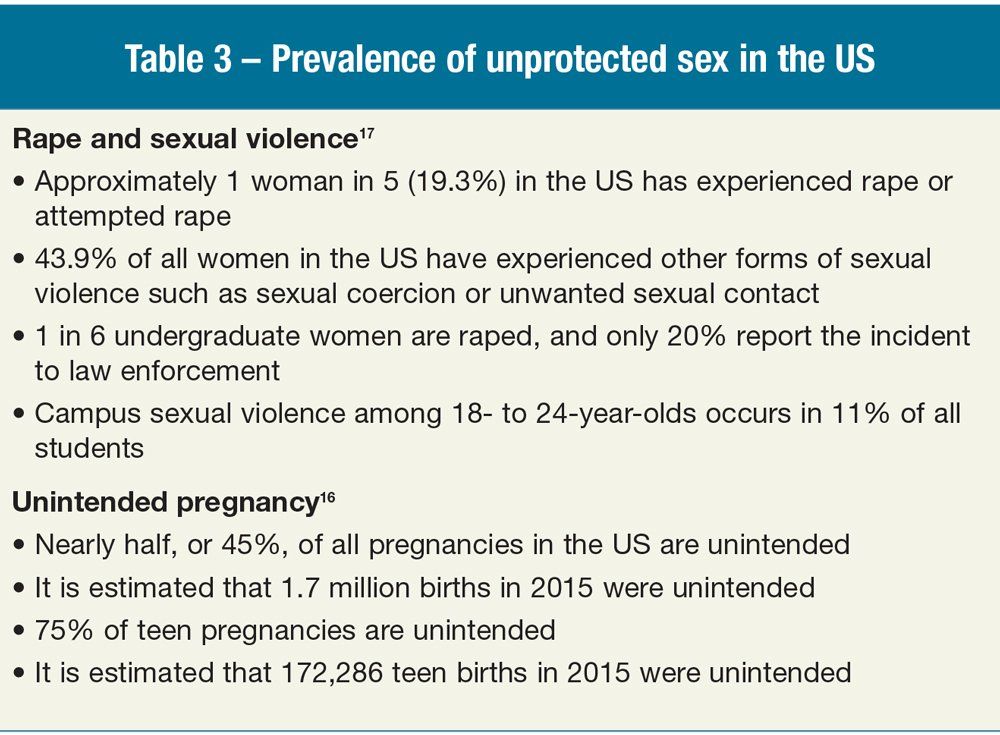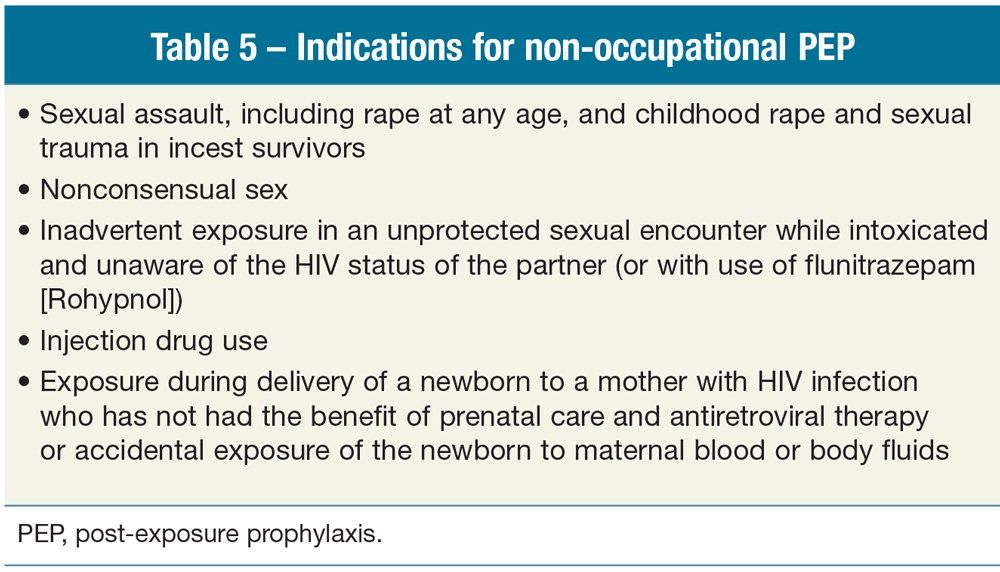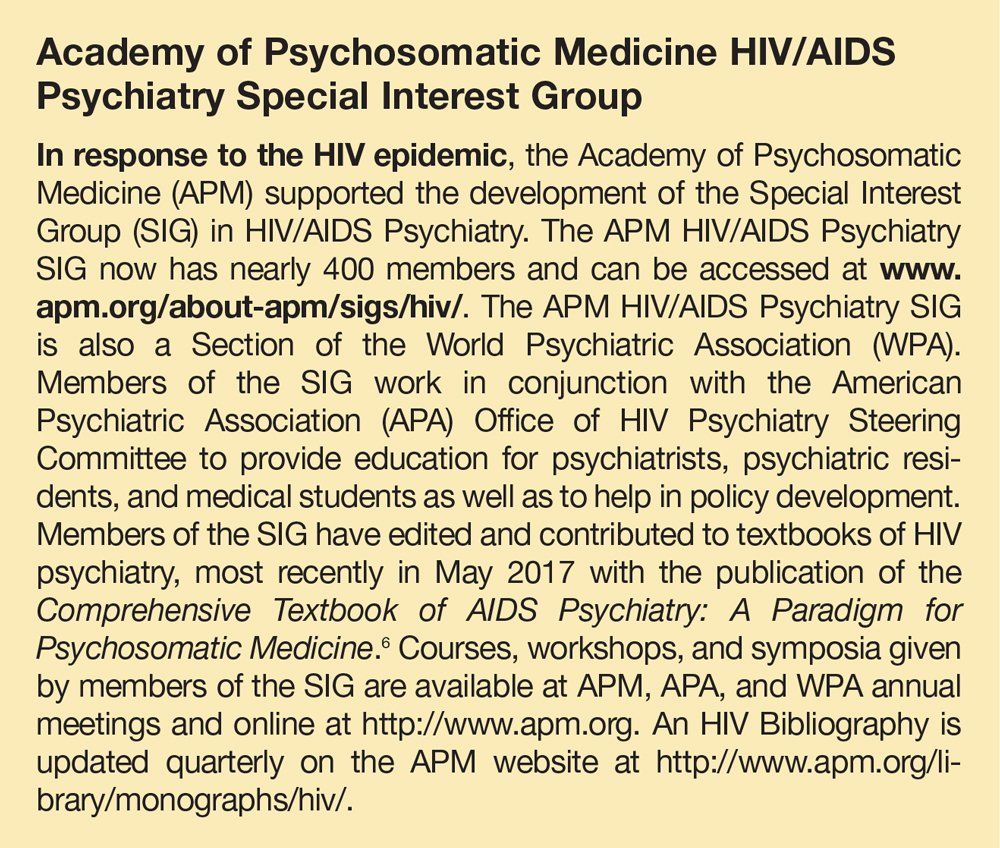How Psychiatrists Can Prevent HIV Transmission With Pre- and Post-Exposure Prophylaxis
This article delineates the role of psychiatrists in preventing HIV transmission before and after HIV exposure through pre- and post-exposure prophylaxis.
Table 1 – Suggestions for a multidimensional approach to HIV prevention

Table 2 – Persons for whom PrEP is recommended

Table 3 – Prevalence of unprotected sex in the US

Table 4 – The differences between PEP and PrEP

Table 5 – Indications for non-occupational PEP

Academy of Psychosomatic Medicine HIV/AIDS Psychiatry Special Interest Group

Strategies have been developed to prevent HIV transmission and to improve adherence to risk reduction and medical care. These include the National AIDS Strategy for the United States Updated to 2020, the 2015 Blueprint on Ending AIDS in New York State by 2020, and the World Health Organization Guidelines.1-4 For any HIV prevention strategies to be implemented, physicians in all specialties need to be aware of them. An article in a previous issue of Psychiatric Times5 and a textbook6 have described the role of psychiatrists in a comprehensive approach to HIV prevention.
This article provides a brief overview of the comprehensive approach and delineates the specific role of psychiatrists in the prevention of HIV transmission both before and after HIV exposure through pre-exposure prophylaxis (PrEP) and post-exposure prophylaxis (PEP). Table 1 provides suggestions for a multidimensional approach to HIV prevention.
Many physicians do not know that transmission can be prevented both before and after exposure to HIV. Psychiatrists can refer HIV-negative persons at substantial risk for infection for PrEP before exposure and PEP after exposure to HIV.7-12
The unique role of psychiatrists and mental health clinicians in HIV prevention
In the US, 1.2 million people are living with HIV, and 1 in 8 does not know that he or she is infected.12 The annual rate of new infections in the US has remained relatively stable over the past decade at a rate of 40,000 to 50,000 new infections each year. The prevalence of HIV infection is higher among persons with mental illness than in the general population, and the prevalence of psychiatric disorders and emotional distress among persons with HIV infection is also higher than in the general population.
HIV is transmitted sexually as well as by injection drug use. However, any substance misuse can play an important role in HIV transmission, since alcohol, stimulants, and other drugs may cause intoxication, impair judgment, and lead to risky behaviors such as unprotected or coerced sexual encounters.
Psychiatrists and other mental health clinicians can play an important role in a comprehensive approach to HIV prevention and engagement in care. Psychiatrists in every subspecialty from child and adolescent to geriatric, addiction, or psychosomatic medicine will encounter opportunities for HIV prevention in every setting from emergency departments and general care to inpatient and ambulatory care. Mental health clinicians in every discipline from addiction counselors to social workers, psychiatric nurse clinicians and practitioners, and psychologists will encounter opportunities for HIV prevention in every setting from emergency departments to drug rehabilitation, methadone maintenance, general care, and inpatient and ambulatory psychiatry. Psychiatrists can prevent HIV transmission by:
• Including HIV testing as part of every routine initial evaluation
• Evaluating for substance use and misuse
• Assessing sexuality and sexual function
• Determining whether a person is HIV negative and at substantial risk for HIV infection
• Making a recommendation and referral for PEP or PrEP that can be lifesaving and has public health implications
What psychiatrists need to know about PrEP
Psychiatrists can make a recommendation for PrEP for persons who are not infected with HIV but who are at substantial risk for infection. Psychiatrists can refer persons at risk to HIV clinicians for PrEP but need to know enough about it to make the referral. PrEP comprises continual daily oral antiretroviral medication that is initiated before potential exposure to HIV as a means of reducing the risk of infection among HIV-negative persons at high risk. Persons who are at ongoing and substantial risk of HIV infection include HIV-negative partners of HIV-positive persons and persons who inject drugs (Table 2).7,8
Medications for PrEP
PrEP allows people who are at substantial risk for HIV infection to reduce their risk by taking antiretroviral medications on an ongoing basis. The medications for healthy adults and adolescents are tenofovir disoproxil fumarate (tenofovir DF or TDF) 300 mg with emtricitabine 200 mg formulated in a single pill to be taken once daily for HIV prevention on a continual basis.
In both sexual transmission and parenteral transmission in injection drug use, there is strong evidence that PrEP can help stop the virus from establishing a permanent infection when used consistently.12-15 Consistent use of PrEP can decrease HIV transmission by 92%.7,8
The evidence for the effectiveness of PrEP is strong. When PrEP is used consistently and in combination with other preventive measures, the risk of HIV transmission may be not only reduced, but may be eliminated.
What psychiatrists need to know about PEP
There is evidence of a high prevalence of unprotected sex in the US. The prevalence of rape and sexual molestation is high throughout the US, as is the incidence of unintended pregnancy (Table 3).16,17
While rape is a crime and unintended pregnancy is an accident, both entail a lack of or incorrect use of barrier contraception. Both events can result in the transmission of HIV and other sexually transmitted diseases as well as hepatitis C.
Psychiatrists can prevent HIV infection before exposure by many measures, and they can prevent infection after exposure by recommending PEP. PEP differs from PrEP in the indications for use, medications used, duration of treatment, and lack of a very strong evidence base for treatment (Table 4).
Despite the lack of strong evidence, PEP is useful for reducing HIV transmission when it is started as rapidly as possible following an isolated exposure. According to the CDC9:
The most effective methods for preventing human immunodeficiency virus (HIV) infection are those that protect against exposure. Antiretroviral therapy cannot replace behaviors that help avoid HIV exposure (eg, sexual abstinence, sex only in a mutually monogamous relationship with an HIV-uninfected partner, consistent and correct condom use, abstinence from injection drug use, consistent use of sterile equipment by persons unable to cease injection drug use). Provision of antiretroviral medication after isolated sexual, injection drug use, or other non-occupational HIV exposure, known as non-occupational PEP, is less effective at preventing HIV infection than avoiding exposure.
For persons who have isolated inadvertent or forced exposure to blood or body fluids by sexual contact or inadvertent injection drug use with a contaminated needle, non-occupational PEP may be used to prevent infection. (Occupational PEP-when PEP is used after accidental occupational exposure-is not addressed in this article.) Indications for non-occupational PEP are provided in Table 5.
Psychiatrists should evaluate and refer persons rapidly for non-occupational PEP when a patient presents for care. A potentially high-risk exposure typically involves direct contact with potentially infectious body fluids or secretions, either through sex or sharing injection equipment with someone who has or might have HIV infection. Exposure to HIV is a medical emergency. HIV establishes infection very quickly, often within 24 to 36 hours after exposure.17,18 Ideally, referral should be as early as possible but must be within 72 hours after a non-occupational exposure that poses substantial risk for HIV transmission.
1) All persons considered for non-occupational PEP should have determination of their HIV infection status by HIV testing, preferably by using rapid combined Ag/Ab or antibody blood tests.
2) If rapid HIV blood test results are unavailable, and non-occupational PEP is otherwise indicated, it should be initiated without delay. It can be discontinued if the patient is later determined to have HIV infection already or the source is determined not to have HIV infection.
3) Non-occupational PEP is recommended when the source of the body fluids is known to be HIV-positive and the reported exposure presents a substantial risk of transmission.
4) Non-occupational PEP is not recommended when the reported exposure presents no substantial risk of HIV transmission.
5) Non-occupational PEP is not recommended when care is sought more than 72 hours after potential exposure.
6) A case-by-case determination about non-occupational PEP is recommended when the HIV status of the source of the body fluids is unknown and the reported exposure presents a substantial risk of transmission if the source did have HIV infection.
The PEP medication regimen differs from that of the PrEP regimen. It consists of the following for healthy adults and adolescents: tenofovir disoproxil fumarate (tenofovir DF or TDF) 300 mg with emtricitabine 200 mg once daily plus raltegravir (RAL) 400 mg twice daily or dolutegravir (DTG) 50 mg daily. PEP also differs from PrEP in duration of use. PEP is recommended for 28 days after exposure while PrEP is prescribed on an ongoing basis for as long as an HIV-negative individual is at substantial risk for infection.
Conclusion
Through a basic understanding of PrEP and PEP, psychiatrists can play an important role in HIV prevention. Psychiatrists are uniquely poised to use their skills not only to treat psychiatric disorders but also to provide HIV treatment recommendations that protect their patients and the community from HIV transmission.
Acknowledgment-Dr. Cohen acknowledges the Academy of Psychosomatic Medicine (APM) for helping to bring this article to fruition. The APM is the professional home for psychiatrists providing collaborative care bridging physical and mental health. Over 1200 members offer psychiatric treatment in general medical hospitals, primary care, and outpatient medical settings for patients with comorbid medical conditions.
Disclosures:
Dr. Cohen is Chair and Founder of the Academy of Psychosomatic Medicine HIV/AIDS Psychiatry Special Interest Group; she is a Member, APA Office of HIV Psychiatry Steering Committee; and she is Clinical Professor of Psychiatry, Icahn School of Medicine, Mount Sinai, NYC.
References:
1. Health Resources and Services Administration. National HIV/AIDS Strategy for the United States: Updated to 2020. https://hab.hrsa.gov/about-ryan-white-hivaids-program/national-hivaids-strategy-updated-2020. Accessed July 6, 2017.
2. The White House 2016. National HIV/AIDS Strategy for the United States: Updated to 2020, 2016 Progress Report, December 2016. https://www.whitehouse.gov/sites/whitehouse.gov/files/images/nhas-2016-progress-report.pdf. Accessed July 6, 2017.
3. The New York State Department of Health. 2015 Blueprint on Ending AIDS in New York State by 2020. https://www.health.ny.gov/diseases/aids/ending_the_epidemic/docs/blueprint.pdf. Accessed July 6, 2017.
4. World Health Organization 2016. World Health Consolidated guidelines on HIV prevention, diagnosis, treatment and care for key populations 2016 update. http://www.who.int/hiv/pub/guidelines/keypopulations-2016/en/. Accessed July 6, 2017.
5. Cohen MA, Cozza KL, Bourgeois JA, et al, and the Academy of Psychosomatic Medicine. The role of psychiatrists in HIV prevention. Psychiatric Times. March 2016;33:30-32.
6. Cohen MA, Gorman M, Volberding P, et al, eds. Comprehensive Textbook of AIDS Psychiatry: A Paradigm for Psychosomatic Medicine. 2nd ed. New York; Oxford University Press: 2017.
7. Centers for Disease Control and Prevention. US Public Health Service Pre-exposure Prophylaxis for the Prevention of HIV Infection in the United States: 2014 Clinical Practice Guideline. www.cdc.gov/hiv/pdf/guidelines/PrEPguidelines2014.pdf. Accessed July 7, 2017.
8. Centers for Disease Control and Prevention. Pre-exposure Prophylaxis PrEP, 2016. https://www.cdc.gov/hiv/risk/prep/. Accessed July 7, 2017.
9. Centers for Disease Control and Prevention. Updated Guidelines for Antiretroviral Postexposure Prophylaxis After Sexual, Injection Drug Use, or Other Nonoccupational Exposure to HIV: United States, 2016. https://www.cdc.gov/hiv/pdf/programresources/cdc-hiv-npep-guidelines.pdf. Accessed July 7, 2017.
10. Centers for Disease Control and Prevention. CDC Stacks. Updated Guidelines for Antiretroviral Postexposure Prophylaxis After Sexual, Injection Drug Use, or Other Non-occupational Exposure to HIV: United States, 2016. https://stacks.cdc.gov/view/cdc/38856. Accessed July 7, 2017.
11. Centers for Disease Control and Prevention. CDC Stacks. Recommendations for HIV Prevention with Adults and Adolescents with HIV in the United States, 2014: Summary for Clinical Providers. 2014. http://stacks.cdc.gov/view/cdc/26063. Accessed July 7, 2017.
12. Baeten JM, Donnell D, Ndase P, et al; Partners PrEP Study Team. Antiretroviral prophylaxis for HIV prevention in heterosexual men and women. N Engl J Med. 2012;367:399-410.
13. Grant RM, Lama JR, Anderson PL, et al; iPrEx Study Team. Pre-exposure chemoprophylaxis for HIV prevention in men who have sex with men. N Engl J Med. 2010;363:2587-2599.
14. Thigpen MC, Kebaabetswe PM, Paxton LA, et al; TDF2 Study Group. Antiretroviral pre-exposure prophylaxis for heterosexual HIV transmission in Botswana. N Engl J Med. 2012;367:423-434.
15. Choopanya K, Martin M, Suntharasamai P, et al; Bangkok Tenofovir Study Group. Antiretroviral prophylaxis for HIV infection in injecting drug users in Bangkok, Thailand: a randomised, double-blind, placebo-controlled phase 3 trial. Lancet. 2013;381:2083-2090.
16. Centers for Disease Control and Prevention. Unintended Pregnancy Prevention, 2016. https://www.cdc.gov/reproductivehealth/contraception/unintendedpregnancy/index.htm. Accessed July 7, 2017.
17. Basile KC, DeGue S, Jones K, et al. STOP SV: A Technical Package to Prevent Sexual Violence. https://www.cdc.gov/violenceprevention/pdf/SV-Prevention-Technical-Package.pdf. Accessed July 7, 2017.
18. New York State Department of Health AIDS Institute, 2014. HIV Prophylaxis for Victims of Sexual Assault. https://www1.nyc.gov/assets/doh/downloads/pdf/csi/csi-pep-hcp-faq.pdf. Accessed July 7, 2917.
